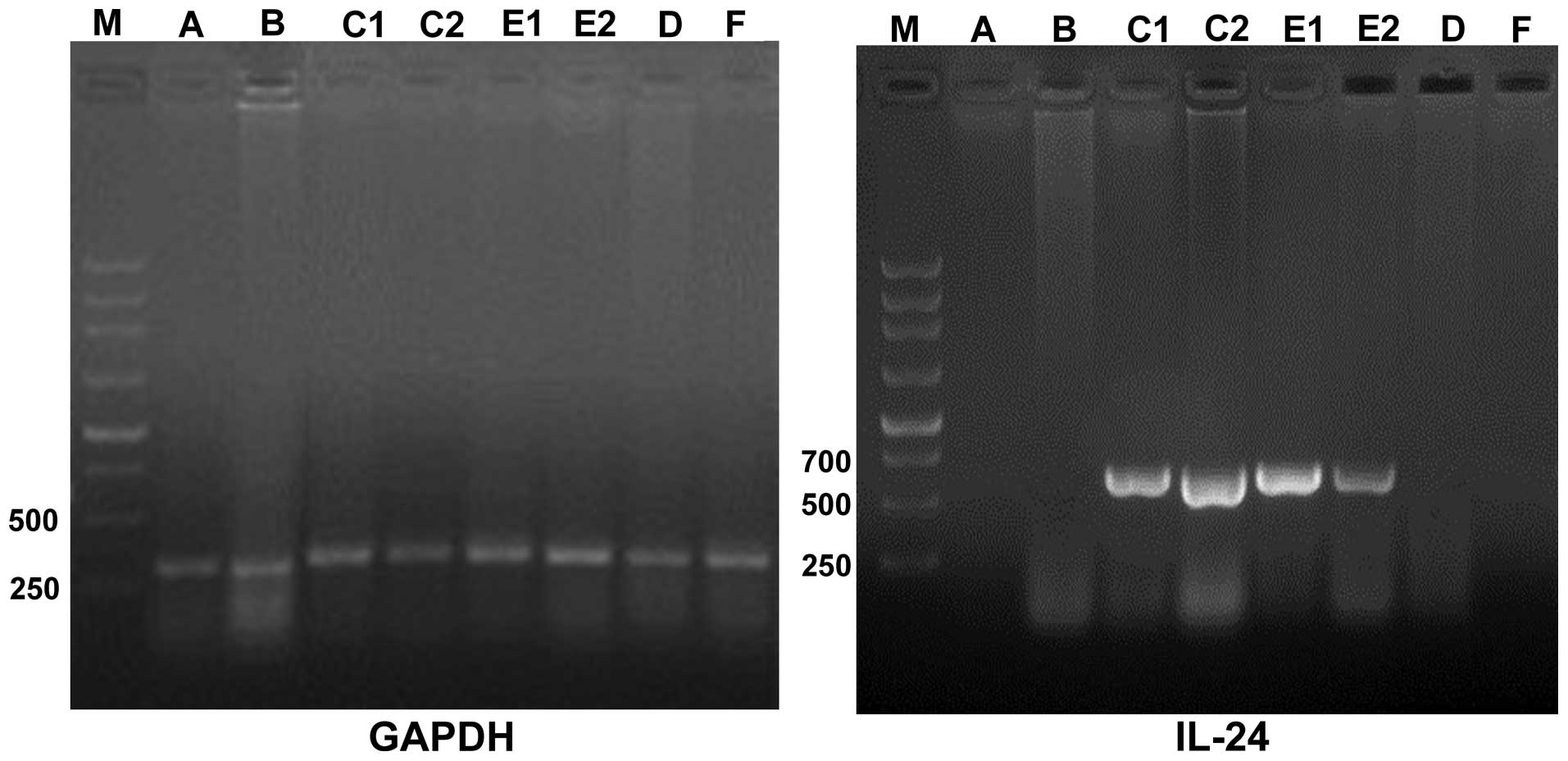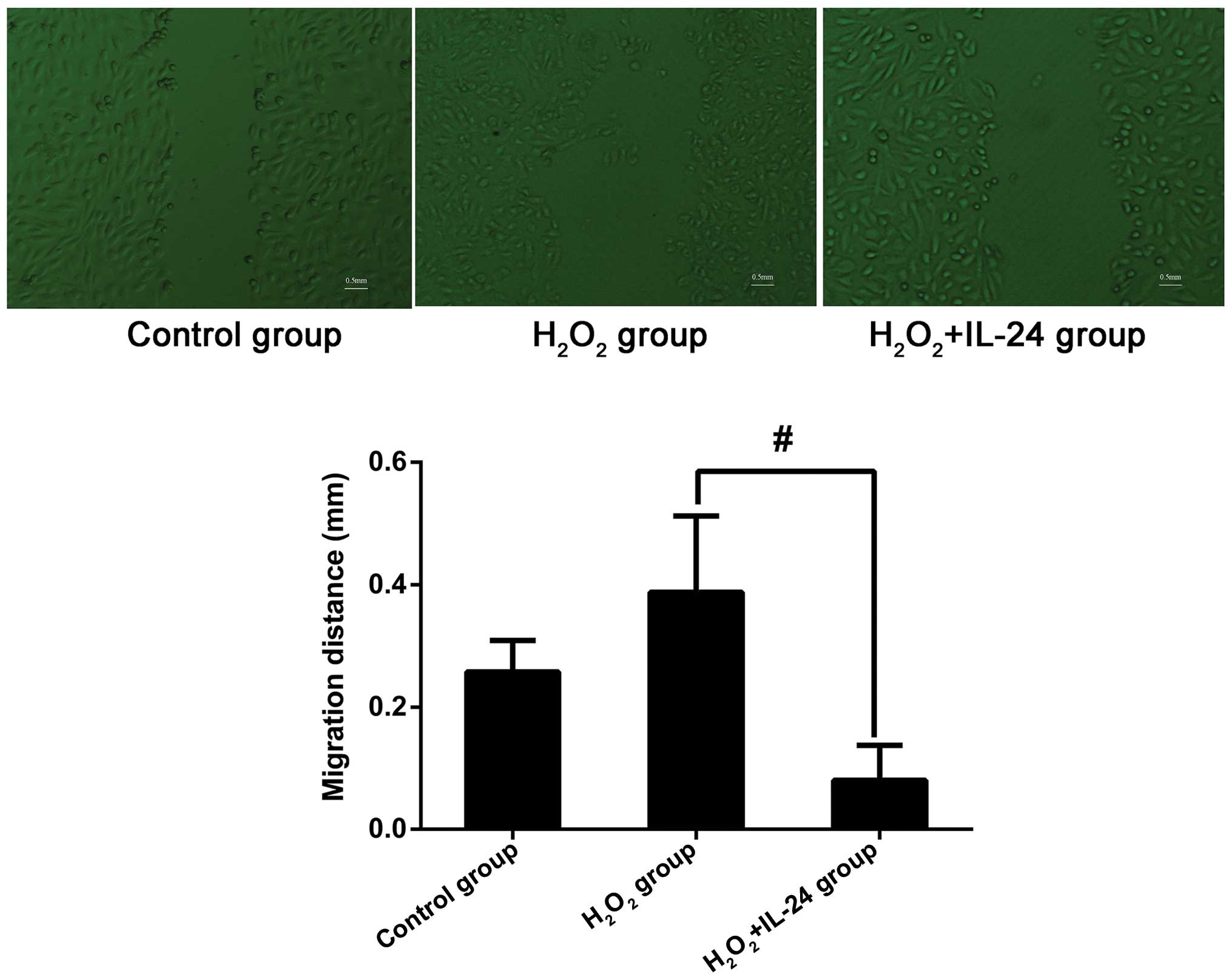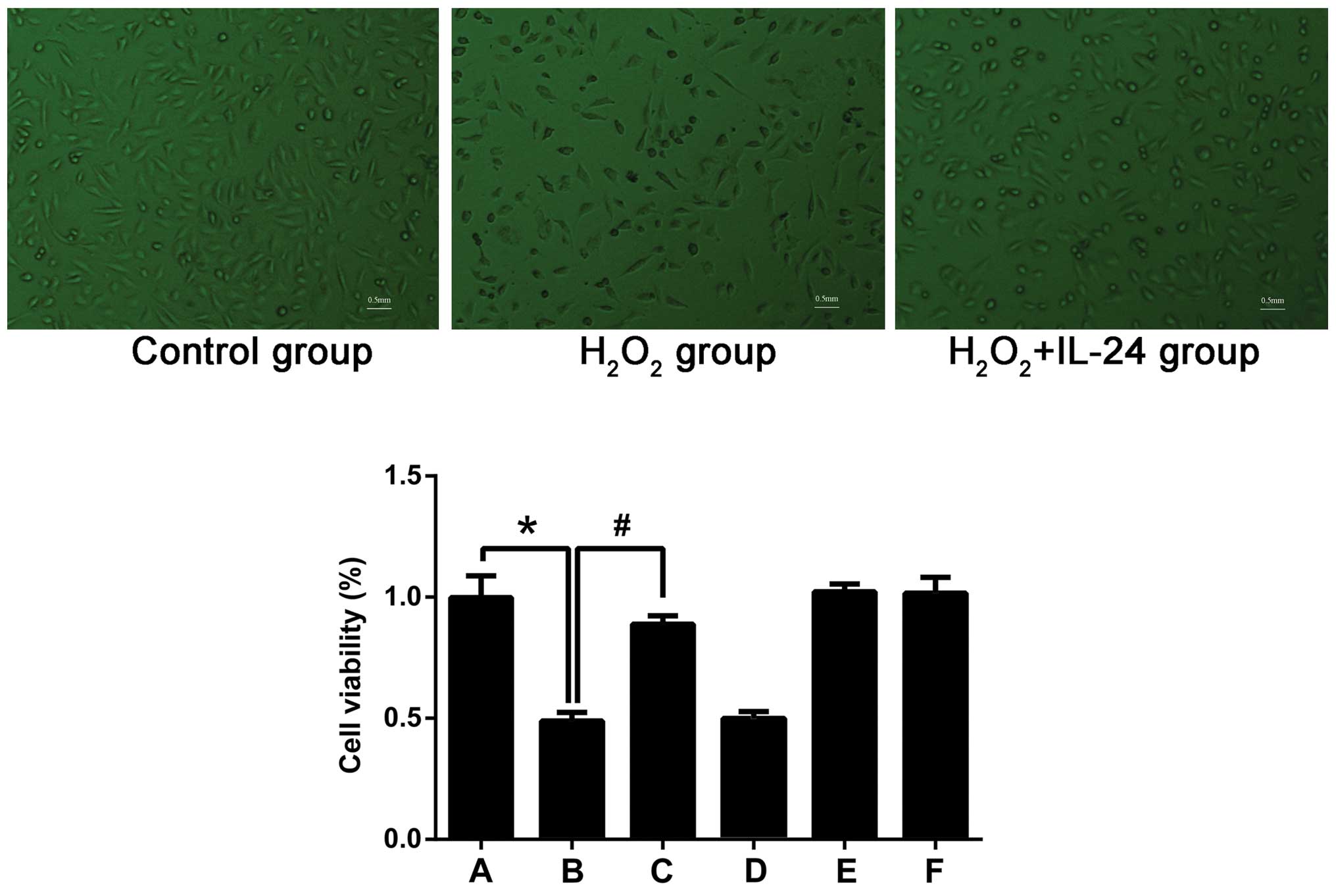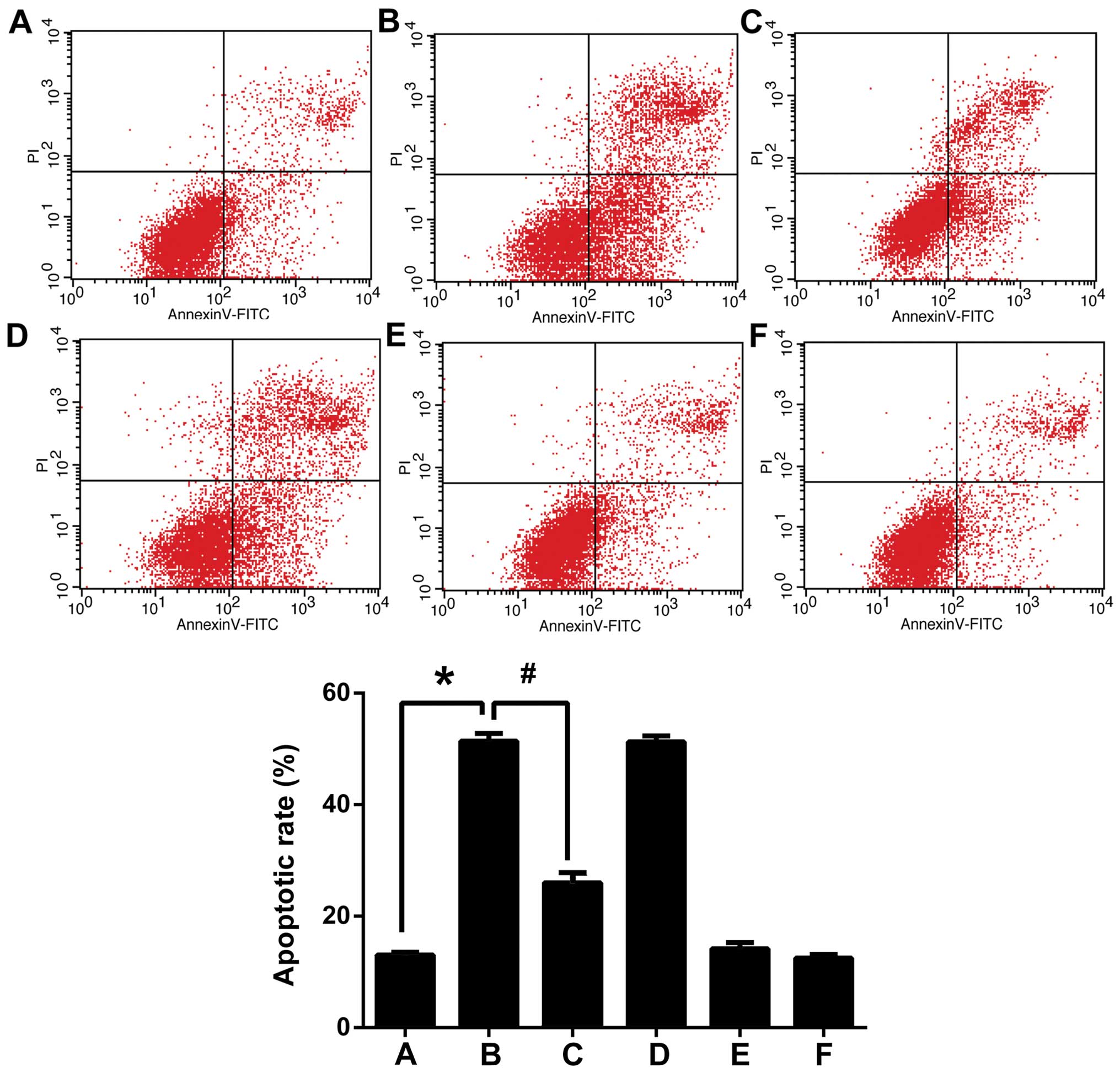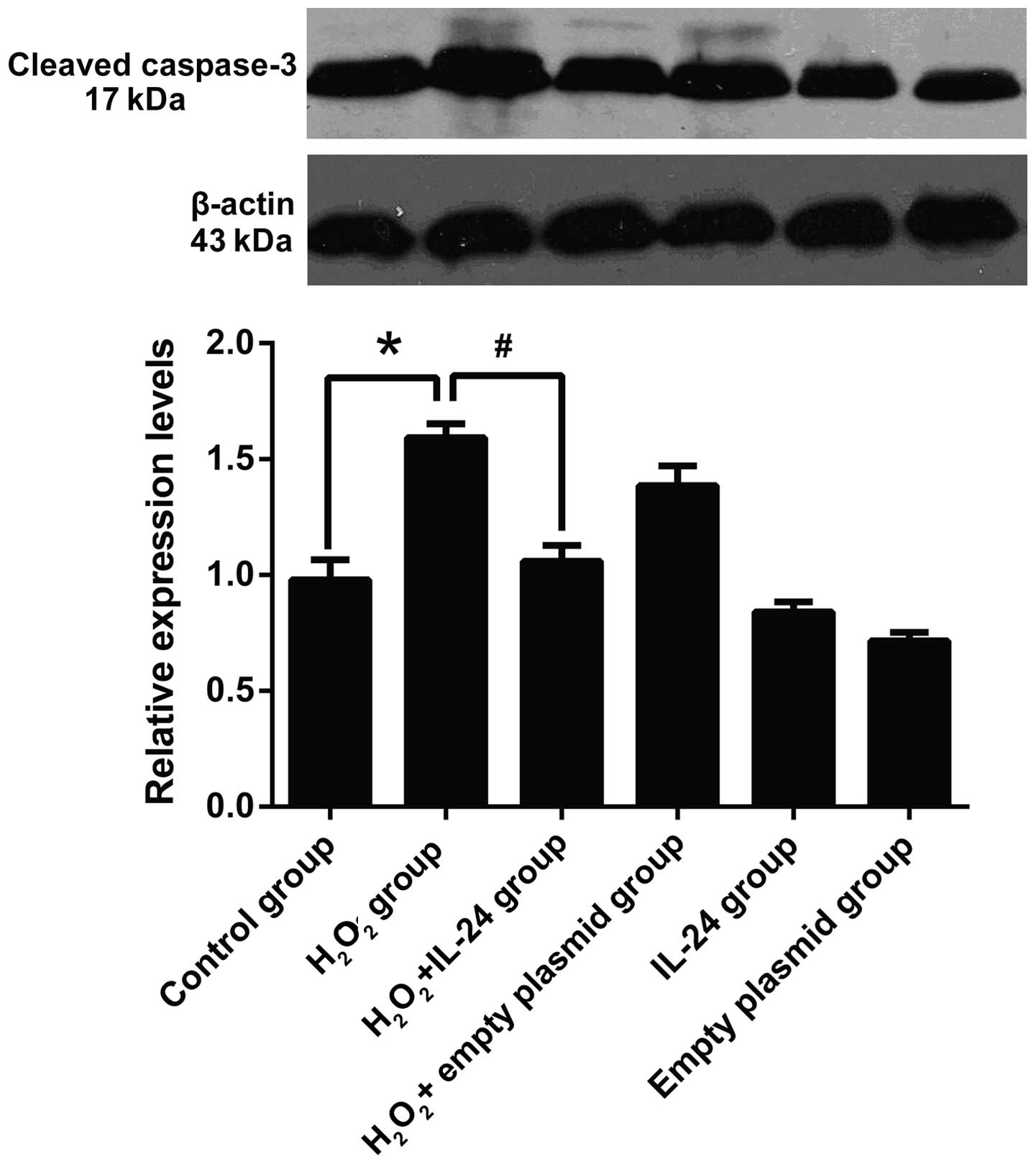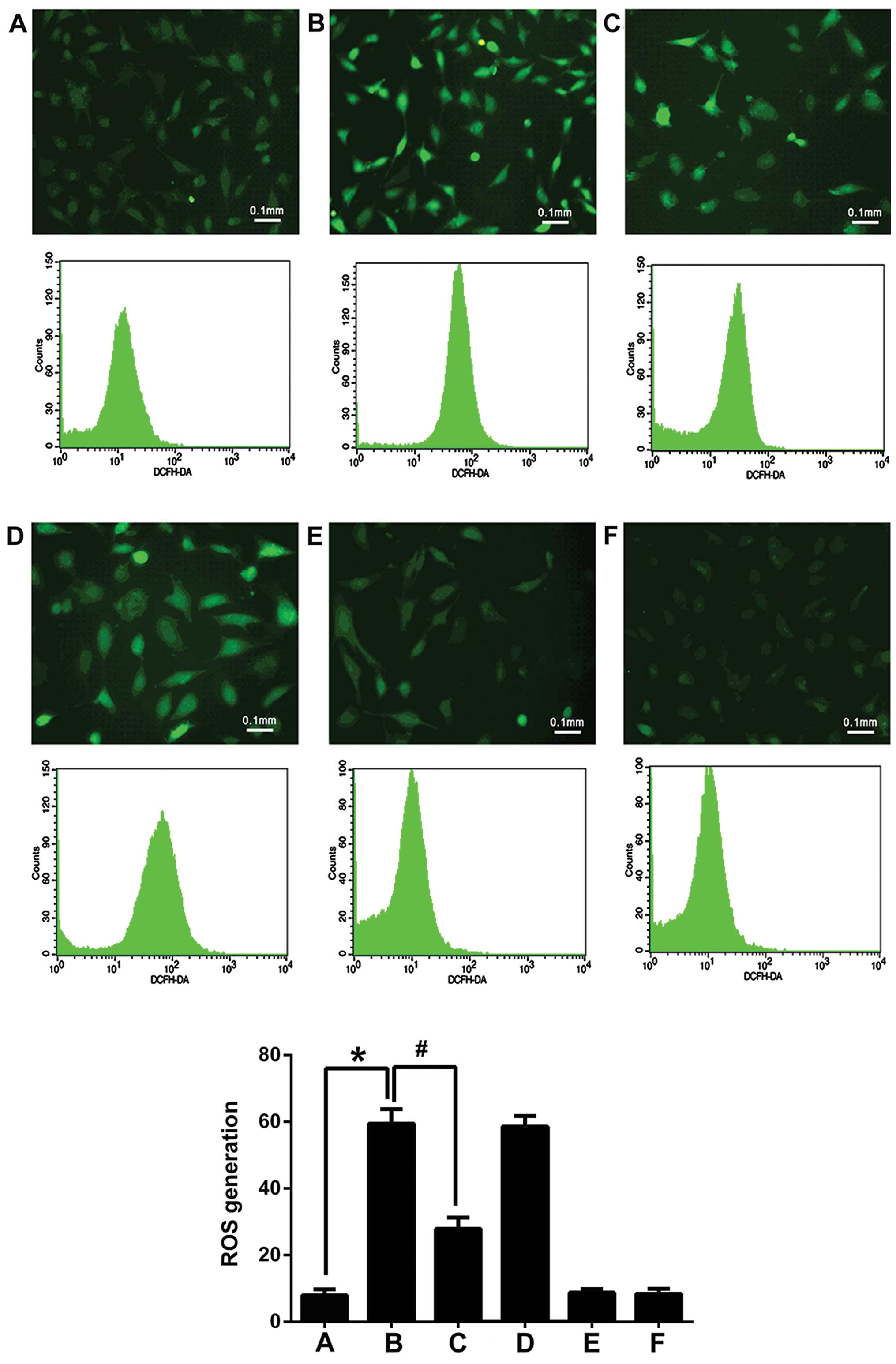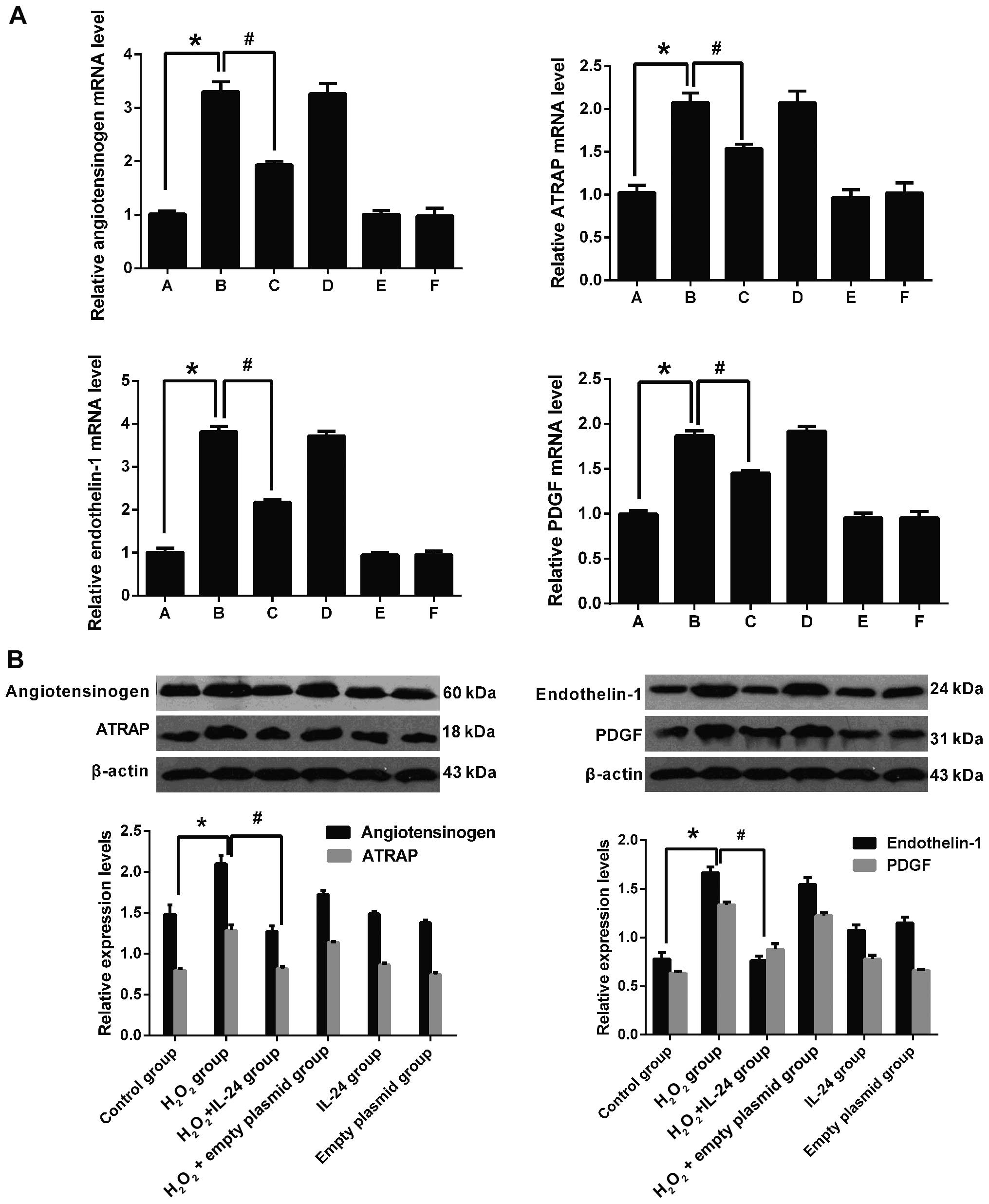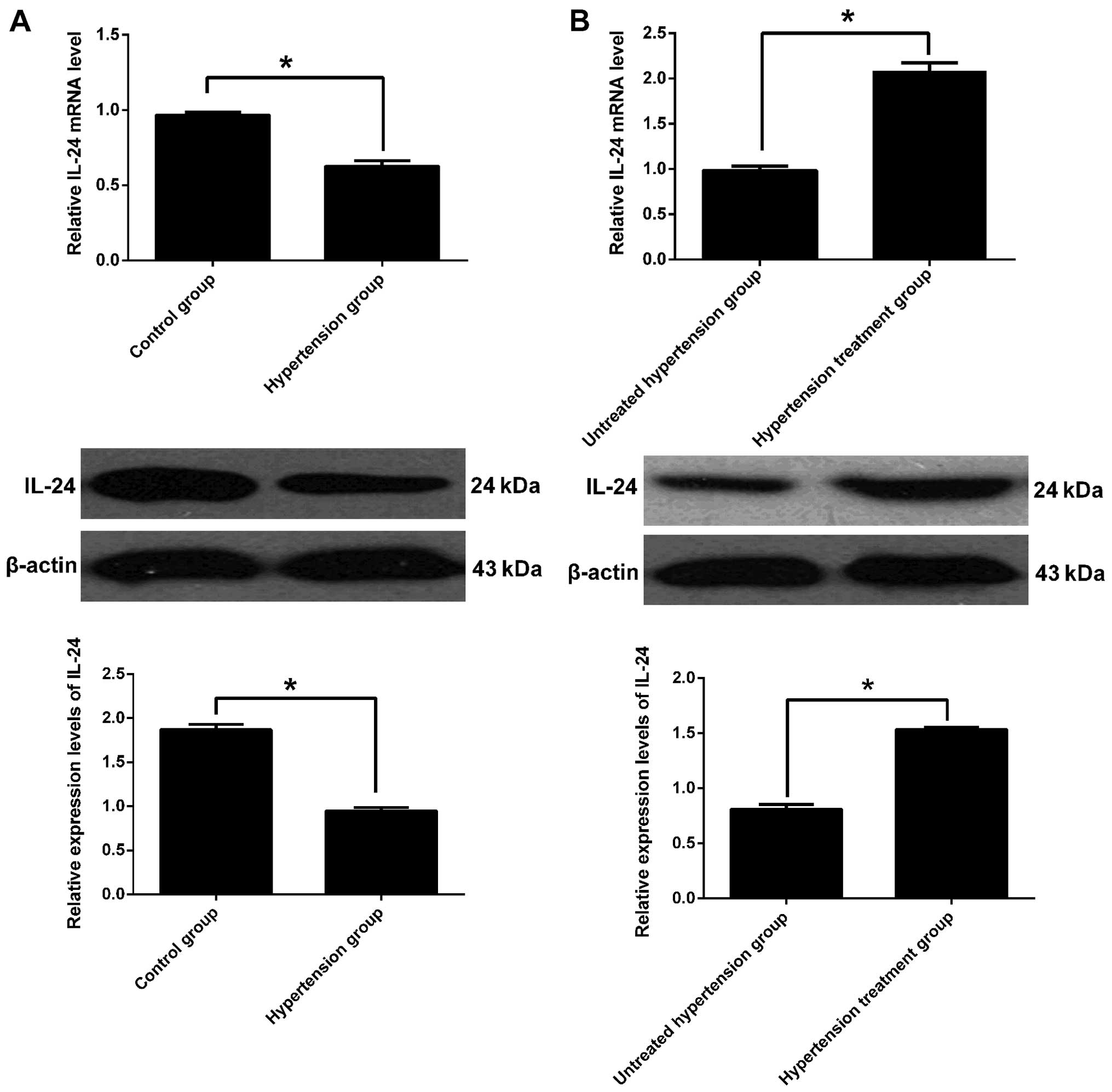The IL-24 gene protects human umbilical vein endothelial cells against H2O2-induced injury and may be useful as a treatment for cardiovascular disease
- Authors:
- Published online on: January 25, 2016 https://doi.org/10.3892/ijmm.2016.2466
- Pages: 581-592
-
Copyright: © Wang et al. This is an open access article distributed under the terms of Creative Commons Attribution License.
Abstract
Introduction
Hypertension is an important risk factor for the development of cardiovascular disease. In addition to causing damage to the heart, hypertension can also cause stress and damage to several other organs and tissues, including the brain, liver, kidneys and vascular tissue (1,2). Previous studies have described the effects of high blood pressure on heart and brain tissue damage, showing that such effects can lead to myocardial hypertrophy and stroke (3). There are significant data showing that treatment with anti-hypertensive drugs leads to changes in gene expression in the kidneys and bladder tissue (4,5). Additionally, a recent study demonstrated that treatment with such drugs may also result in changes in gene expression directly in the heart, brain and liver tissues (6). The authors reported on differentially expressed genes following treatment with anti-hypertensive drugs. While 33 of these genes were previously linked to cardiovascular disease, this analysis also led to the identification of 16 novel genes with no known link to cardiovascular disease; some of the 16 newly identified genes included interleukin (IL)-24, cathepsin Z (Ctsz), and secretory carrier membrane protein (Scamp2). Genes that are differentially expressed following treatment with anti-hypertensive drugs may be potential biomarkers and novel targets for the prevention of cardiovascular disease. Moreover, such genes may provide valuable information for the development of new anti-hypertensive therapy (6).
Initially identified in 1995 during a melanoma cell treatment regimen, IL-24 [also known as melanoma differentiation associated gene-7 (MDA-7)] possesses tumor suppressor characteristics (7). IL-24 cDNA encodes a protein of 206 amino acids with molecular weight of 23.8 kDa. N-terminal signal peptide sequences have indicated that IL-24 is a secreted protein (8). The transfer of recombinant IL-24 into mononuclear cells in human peripheral blood has been shown to lead to the release of IL-6, interferon (IFN)-γ, tumor necrosis factor (TNF)-α, IL-12, and granulocyte-macrophage colony-stimulating factor (GM-CSF), lending to its characterization as a bona fide cytokine (8). Adenovirus-mediated IL-24 expression has been shown to inhibit the growth of vascular endothelial cells in tumor tissues, suggesting that IL-24 may inhibit angiogenesis (9). In human melanoma, the loss of IL-24 has been shown to be closely associated with tumor invasion and metastasis, suggesting that IL-24 may be a tumor suppressor in this setting as well (10).
Since IL-24 inhibits cancer cell proliferation through multiple biological pathways, it may also exert anti-proliferative effects in occlusive vascular disease. It has been demonstrated that both atherosclerosis and cancer may originate from local tissue injury, which can promote inflammation and genomic instability (11). Whereas some researchers have worked to elucidate the role of IL-24 in cancer (12–14,49), its role in cardiovascular disease remains unclear.
A number of cardiovascular diseases, including ischemia/reperfusion injury and myocardial infarction, have been shown to be closely associated with cellular apoptosis (15). Reactive oxygen species (ROS), such as hydrogen peroxide (H2O2), can lead to the development of cardiovascular disease by promoting the apoptosis of endothelial cells (16,17). Protecting endothelial cells from apoptosis has a positive clinical significance in the prevention and treatment of cardiovascular disease. Some have proposed repairing endothelial cell injury as part of hypertension treatment and have suggested that the degree of injury may be indicative of disease severity (18,47). As such, the detection of endothelial cell dysfunction is clinically important.
To date, to the best of our knowledge, there are no studies available describing the protective effects of IL-24 on vascular endothelial cells following injury. Previous studies have suggested that the adenovirus-mediated introduction of tumor suppressor genes, such as retinoblastoma (RB), p53, p21 and phosphatase and tensin homolog (PTEN) inhibits vascular smooth muscle cell (VSMC) proliferation and neointima formation following vascular injury in vivo (19–22). However, the potential effects of IL-24 on oxidative damage and the abnormal proliferation of vascular endothelial cells have not yet been reported.
In the present study, we examined whether IL-24 exerts protective effects on vascular endothelial injury induced by oxidative stress, and whether it is a therapeutic target of anti-hypertensive drugs in the cardiovascular system. Performing cellular experiments, we found that IL-24 protected against H2O2-induced endothelial cell damage, and that the expression of IL-24 could be altered by an increase in blood pressure and anti-hypertensive drug therapy in a rat model of hypertension. Our results revealed that the IL-24 gene is closely related to cardiovascular disease and may thus provide a novel therapeutic target for the treatment of cardiovascular disease.
Materials and methods
Materials and reagents
Human umbilical vein endothelial cells (HUVECs) were obtained from the Shanghai Institute of Cell Biology, Chinese Academy of Sciences, China. Normal male Sprague Dawley (SD) rats (n=36, 6–7 weeks old; weight, 225±25 g) were purchased from the Academy of Military Medical Sciences (Beijing, China). Dulbecco's modified Eagle's medium (DMEM) and trypsin were from Gibco Life Technologies (Grand Island, NY, USA); fetal bovine serum (FBS) was obtained from (HyClone (Logan, UT, USA); the hypertension construction pump (ALZET miniosmotic pump) was from Durect Corp., (Cupertino, CA, USA); angiotensin II was purchased from Sigma-Aldrich (St. Louis, MO, USA); the IL-24 recombinant shuttle plasmid, pDC316-h IL-24, and the empty plasmid, pDC316, were obtained from Benyuan Zhengyang Gene Technology Co. Ltd. (Beijing China); the plasmid extraction and purification kit was purchased from Bioer Technology Co., Ltd. (Hangzhou, China); the liposome transfection reagent, Lipofectamine® 2000, was from Invitrogen (Carlsbad, CA, USA); the Cell Counting Kit-8 (CCK-8) was obtained from the Beyotime Institute of Biotechnology (Shanghai China); the ROS test kit was from Beijing Applygen Technology Ltd. (Beijing, China); the Annexin V/PI staining kit was obtained from Nanjing KGI Biotechnology Development Co., Ltd. (Nanjing, China). The anti-cleaved caspase-3 antibody [(Asp175) Western Blot Detection Kit] was from Cell Signaling Technology, Inc., (Danvers, MA, USA); anti-IL-24 [EPR13281] antibody (ab182567) was from Abcam (Cambridge, UK); anti-endothelin-1/ET-1 (N-8) (sc-21625), anti-angiotensin II type 1 receptor-associated protein (AGTRAP/ATRAP) (F-6) (sc-271367), anti-angiotensin (H-12) (sc-374511) and anti-platelet-derived growth factor (PDGF-A) (H-77) (sc-7958) antibodies were all from Santa Cruz Biotechnology, Inc. (Heidelberg, Germany).
Cell culture
The HUVECs were grown in DMEM supplemented with 10% (v/v) heat-inactivated FBS and 1% (v/v) penicillin-streptomycin at 37°C in a humidified atmosphere containing 5% CO2. All experiments were performed using cells cultured for 3–4 days at approximately 80–90% confluency.
Cell experimental groups
The cells were divided into the following groups: in group A, control cells cultured in DMEM with 10% FBS. In group B, cells were exposed to H2O2 (0.10 or 0.30 mmol/l). In group C, the cells were exposed to H2O2 (same concentrations of H2O2 described above) and also treated with IL-24. The cells in this group were transfected with the recombinant plasmid, pDC316-h IL-24 (100 ng/ml) using Lipofectamine 2000 to promote IL-24 expression. In group D, the cells were treated with H2O2, but transfected with the empty plasmid (served as a control). The other 2 control groups were group E and F. In group E, the cells were transfected only with the recombinant plasmid, pDC316-h IL-24. In group F, the cells were transfected only with the empty plasmid. The cells were examined by fluorescence microscopy for transfection efficiency at 24 h post-transfection. The cells incubated for 48 h to determine the protective effects of IL-24 against H2O2.
Animal grouping and intervention
The normal SD rats were divided into a control group (n=12) and a hypertension group (n=24). An osmotic micropump was used to generate the model of hypertension, as previously described (23,24). The osmotic pump with the pre-placement of angiotensin II was implanted subcutaneously. The infusion of angiotensin II was carried out by subcutaneous implantation [500 ng/(kg·min), 7 days]. Blood pressure was recorded daily using a BP-6 animal non-invasive blood pressure measuring instrument (Chengdu Taimeng Technology Co., Ltd., Chengdu, China). The tail artery blood pressure of the rats was measured using the tail-cuff method. The rats are arranged in the heating device, which was heated to 37°C for 3 min, then the tail was connected with the sensor, while the rats were in a quiescent state; food and water was made availabe in the device, which helped to keep the rats calm. Blood pressure was measured without anesthesia with the rats in a quiescent state. The blood pressure of each rat was continuously measured at least 10 times and the average values were calculated.
After successfully establishing the model of hypertension, 12 rats were sacrificed by cervical disclocation 2 weeks after they experienced a spike in blood pressure. The heart and kidney tissues were harvested from these animals, and real-time PCR was performed to detect the expression of IL-24. The remaining 12 hypertensive rats were administered enalapril (35 mg/kg/day; Shanghai Modern Pharmaceutical Ltd., Shanghai, China) and nifedipine (30 mg/kg/day; Beijing Bayer Healthcare Co., Ltd., Beijing, China) orally each day for 3 weeks. This leads to a steady decline in blood pressure; 1 week after the blood pres-sure had decreased and stabilized, the rats were sacrificed and IL-24 gene expression was examined.
Ethics statement
All surgical and animal care procedures were approved by the Institutional Ethics Committee. All research was carried out in strict accordance with the provided guidelines. We abided by all relevant provisions set forth by the Medical Ethics Committee of Shanxi Medical University (Shanxi, China).
Determination of IL-24 transfection efficiency by RT-PCR
Total RNA was extracted from the cells using TRIzol reagent. RNA concentration and purity were determined by UV spectrophotometry prior to reverse transcription and cDNA synthesis. The reaction conditions were as follows: 95°C denaturation for 5 min, followed by 95°C denaturation 30 sec, 58°C annealing 30 sec, 72°C extension 60 sec, cycle 32 times, 72°C terminal extension 7 min, 4°C hold. PCR products were analyzed by 1.0% agarose gel electrophoresis and sequenced by imaging analysis using the IS-10,000 multifunction gel image analysis system (Shanghai Tianneng Technology Co., Ltd., Shanghai, China). The primers used for RT-PCR are listed in Table I. The amplified fragment length of IL-24 was 624 bp and that of glyceraldehyde 3-phosphate dehydrogenase (GAPDH) was 307 bp.
Cell migration assay
The study by Burdon and Gill indicated that H2O2 is an 'information contact' between cells, and that H2O2 is one of the essential materials for cell maintenance (25). H2O2 at low concentration may play the role of a mitogen and can stimulate cell proliferation and migration. We wished to determine whether H2O2 can stimulate cell proliferation and migration. We performed a scratch test to determine the effects of H2O2 (0.1 mmol/l) with or without the presence of IL-24 on HUVEC migration. Briefly, a small scratch was made using a 10-µl pipette tip in the culture dish at time 0, and the distance the cells had migrated was observed at 24 h.
Cytotoxicity assays
Cell viability was measured by CCK-8 assay, according to the manufacturer's instructions (Beyotime Institute of Biotechnology). The cells were seeded in a 96-well plate and transfected with the empty plasmid or IL-24 plasmid the following day using Lipofectamine 2000. At 24 h post-transfection, the cells were switched to serum-free medium for 24 h. They were then exposed to H2O2 (0.30 mmol/l) for 12 h. CCK-8 solution (10 µl) was then added to each well 1 h before the absorbance was measured at 450 nm using a microplate reader (Molecular Devices, LLC, Sunnyvale, CA, USA). Cell viability was determined as follows: cell viability (%) = treatment group OD/control group OD ×100.
Apoptosis assay
Annexin V/PI staining was performed to detect apoptosis. The treated cells were collected, washed and then stained with Annexin V/PI for 20 min in the dark at room temperature. The percentage of apoptotic cells was analyzed by flow cytometry (BD FACSCalibur flow cytometer, FACS101; BIO-RAD Corporation, Hercules, CA, USA).
Determination of intracellular ROS production
Intracellular ROS production was measured by flow cytometry and fluorescence microscopy. Following treatment, the cells were washed and incubated with 2′,7′-dichlorodihydrofluorescein diacetate (DCFH-DA; 10 µmol/l; Sigma-Aldrich) for 20 min at 37°C in the dark. The fluorescence corresponding to the intra-cellular ROS levels was monitored using a light microscope (Olympus BX51; Olympus, Tokyo, Japan) and analyzed by flow cytometry (BD FACSCalibur flow cytometer, FACS101; BIO-RAD Corporation).
Real-time PCR
We used real-time PCR to detect the expression of the hypertension-related factors, angiotensinogen, endothelin-1, ATRAP and PDGF in the HUVECs, as well as IL-24 gene expression in the heart and kidney tissue of the rats in our model of hypertension and following anti-hypertensive therapy. In the cell experiments, total RNA was isolated from the treated HUVECs using RNeasy spin columns obtained from Qiagen (Hilden, Germany). Real-time PCR was performed in triplicate on a Stratagene Mx3005P Multiplex Quantitative PCR system (Stratagene, La Jolla, CA, USA) using 100 ng RNA, 12.5 µl 2X QuantiFast SYBR-Green PCR Master Mix (Qiagen) and 1 µmol each of forward and reverse primers (Table II) in a total final volume of 25 µl. For the tissues, the tissue samples were incubated at 94°C for 10 min. Subsequently, denaturation was performed for 45 cycles at 94°C for 15 sec followed by annealing and extension at 60°C for 60 sec. The amplification products were normalized to β-actin. The expression of the target gene, normalized to β-actin, was calculated using the 2−ΔΔCt method, as previously described (26).
Western blot analysis
We used western blot analysis to detect the expression of cleaved casepase-3, angiotensinogen, endothelin-1, ATRAP and PDGF in the HUVECs, and that of IL-24 in the heart and kidney tissue of the rats. In the cell experiments, protein was extracted from the treated HUVECs and the concentration was determined. Equal amounts of total protein were analyzed on SDS-PAGE gels. The samples were transferred onto a membrane, which was incubated with first primary and then secondary antibodies. The protein bands were visualized by enhanced chemiluminescence (ECL) and autoradiography. Protein bands were analyzed using Quantity One image analysis software. In the animal experiments, specific intervention and treatment times were the same as those described for the determination IL-24 mRNA expression by RT-PCR. Protein was harvested from the rat kidney and heart tissues and was analyzed as described for the cell experiments.
Statistical analysis
We used SPSS 19 software for statistical analysis. Data are presented as the means ± standard deviation. Data were analyzed by one way analysis of variance (ANOVA) and Student's t-test. A value of P<0.05 was considered to indicate a statistically significant difference.
Results
Detection of IL-24 gene transcription in endothelial cells
RT-PCR confirmed the successful transfection and overexpression of IL-24 in endothelial cells in both the H2O2 + IL-24 (group C) and IL-24 (group E) groups (Fig. 1).
IL-24 attenuates the promoting effects of H2O2 on endothelial cell proliferation
Low concentrations of H2O2 (0.1–0.15 mmol/l) can stimulate abnormal cell proliferation and migration, which was determined in our pre-experiments. Compared with the control group, following 24 h of exposure to H2O2, cell proliferation and migration were markedly increased in the H2O2 group compared to the controls (controls, 0.2575±0.05123; H2O2 group, 0.3875±0.01250 mm; P=0.1026>0.05). We found that the overexpression of IL-24 significantly inhibited the H2O2-induced proliferation of the HUVECs (0.0800±0.05715 mm; H2O2 group compared with H2O2 + IL-24 group; P=0.0042<0.05) (Fig. 2).
Cell viability determined by CCK-8 assay
IL-24 significantly decreased the apoptosis induced by oxidative stress, thus improving the survival rate of the cells (Fig. 3). Cell survival in the H2O2 oxidative stress injury group was lowest with a viability of 51±5.57% of the control group (P<0.001). Cell injury due to oxidative stress was significantly attenuated by IL-24, leading to an increase in cell viability to 81.66±4.81% of the control group. The differences in cell viability between the H2O2 and H2O2 + IL-24 groups were statistically significant (P=0.0019<0.05).
Cell apoptosis measured by flow cytometry
The amount of apoptosis induced by H2O2 was significantly higher than the basal level of apoptosis observed in the control group (51.38±1. 39 vs. 13.01±0.50%; P<0.001; Fig. 4). IL-24 was able to protect the cells against H2O2-induced apoptosis (51.38±1.39% in the H2O2 group compared to 25.93±1.902% in the H2O2 + IL-24 group; P<0.001).
Cleaved caspase-3 expression determined by western blot analysis
H2O2 can significantly induced the activation and expression of caspase-3, while this effect was attenuated in H2O2 + IL-24 group. There were significant differences between the control group and the H2O2 group (control group, 0.98±0.086; H2O2 group, 1.59±0.061; P<0.001). The difference between the H2O2 group and the H2O2 + IL-24 group was statistically significant. The mean values were 1.59±0.061, 1.06±0.067, respectively (P<0.001; Fig. 5).
Flow cytometry to measure ROS production in HUVECs
The quantitative detection of ROS production in each treatment group was performed (Fig. 6). The ROS content in the the H2O2 group was significantly higher than in any other group. The difference between the control group and the H2O2 + IL-24 group was statistically significant. The mean values of the ROS content in the H2O2, control and H2O2 + IL-24 groups were 59.43±4.39, 7.97±1.78 and 27.92±3.35, respectively (P<0.001). Taken together, these results indicate that IL-24 decreases cellular ROS levels induced by H2O2, thus reducing damage induced by oxidative stress.
ROS activity in HUVECs detected by fluorescence microscopy
The overexpressio of IL-24 attenuated the H2O2-inducd increase in the intracellular ROS levels. The ROS levels were qualitatively observed by fluorescence microscopy (Fig. 6).
mRNA expression of cardiovascular disease-related factors
Real-time PCR was performed to assess the levels of angiotensinogen, endothelin-1, ATRAP and PDGF. The exposure of the HUVECs to H2O2 significantly increased the mRNA expression of each of these cardiovascular disease-related factors (P<0.001). Importantly, IL-24 attenuated the increase in the levels of these factors (P<0.001; Fig. 7A).
Protein expression of cardiovascular disease-related factors
Western blot analysis was performed to measure the protein expression of angiotensinogen, endothelin-1, ATRAP and PDGF. Consistent with the results observed at the mRNA level, oxidative stress induced by H2O2-induced damage increased expression of these cardiovascular disease-associated factors at the protein level as well. Compared with the control group, each protein was normalized to the levels of β-actin, and the relative expression of angiotensinogen, endo-thelin-1, ATRAP and PDGF was 2.10±0.097/1.48±0.112, 1.66±0.063/0.78±0.065, 1.28±0.068/0.80±0.023 and 1.33±0.031/0.63±0.020, respectively (P<0.001). Compared with the H2O2 group, the relative expression of angiotensinogen, endothelin-1, ATRAP and PDGF in the H2O2 + IL-24 group was 1.28±0.064/2.10±0.097, 0.76±0.046/1.66±0.063, 0.82±0.027/1.28±0.068 and 0.88±0.058/1.33±0.031, respectively (P<0.001). Taken together, our results revealed that IL-24 significantly decreased the expression of cardiovascular disease-related proteins (Fig. 7B).
Successful establishment of the rat model of hypertension
The blood pressure of the normal rats was generally 90–115/67–90 mmHg. Blood pressure was measured at the second day following the infusion of angiotensin II, and blood pressure began to rise thereafter. As shown by continuous monitoring for 7 days, blood pressure was significantly elevated (P<0.05), which shows that the model of hypertension was successfully established. Blood pressure in the control group was 91.72±4.89 mmHg, whereas blood pressure in the hypertension group was 147.35±9.58 mmHg (Table III).
IL-24 mRNA levels in heart and kidney tissue
The transcript levels of IL-24 in the heart and kidney tissue from both the control and hypertensive rats were measured by real-time PCR. The effects of anti-hypertensive therapy were also examined. Compared to the rats in the control group, the IL-24 transcript levels were significantly decreased in the heart and kidney tissue from the hypertensive rats (Fig. 8A, top panel). Following anti-hypertensive therapy, the expression of IL-24 was significantly increased compared to the untreated group (P<0.001; Fig. 8B, top panel).
IL-24 protein levels in heart and kidney tissue
IL-24 protein expression was significantly lower in the hypertensive rats compared to the control rats. The relative expression of IL-24 in the hypertension group, normalized to β-actin, was 0.95±0.041/1.87±0.062 (P<0.001; Fig. 8A, bottom panel). Anti-hypertensive therapy increased IL-24 protein expression; the relative expression in this setting was 1.54±0.014/0.81±0.042 (P<0.001; Fig. 8B, bottom panel). Taken together, our data indicate that IL-24 expression is closely associated with hypertension.
Discussion
ROS play an important role in the pathophysiology of cardiovascular diseases, such as hyperlipidemia, hypertension, ischemic heart disease and chronic heart failure (27). Exogenous H2O2 activates the NAD(P)H oxidase-induced cell production of endogenous H2O2 (27). Intracellular ROS, such as superoxide oxygen ion (O2−), H2O2, and hydroxyl radical (OH−), are associated with the pathogenesis of a number of diseases, such as cardiovascular diseases, including hypertension, heart failure and atherosclerosis, as well as diabetes (28). ROS can cause damage to blood vessel walls; in turn, vascular wall damage can induce changes in the expression of genes associated with cardiovascular diseases (29,30). These genes can stimulate VSMC migration and proliferation, and vascular intima hyperplasia, which lead to the development of cardiovascular disease (31–34).
Methods to reduce and prevent these pathophysiological processes include drug therapy and gene therapy. Compared to drug treatment, gene therapy has the advantage of promoting long-term efficacy with no systemic toxicity (19). Studies have demonstrated that several growth regulatory genes, such as nitric oxide (NO) synthase, Rb and p53 may play a role in preventing neointima formation both in vitro and in vivo (35,36). However, the mechanisms through which these pathophysiological processes can be prevented are still unclear. Theoretically speaking, interfering with multiple biological processes, such as migration, proliferation and apoptosis, should provide the best efficacy. Along these lines, IL-24 has emerged as a promising candidate.
Toxins, such as cigarette smoke or a high-fat diet, can induce molecular pathways that are common to both cardiovascular disease and cancer; such pathways result in oxidative stress and cell damage. Atherosclerosis may arise from the damage or infection of a single arterial smooth muscle cell; in a similar manner, a tumor may arise from an acquired mutation within a single cell. Regulators of cell proliferation, commonly implicated in cancer, are also involved in the progression of atherosclerosis, vascular stenosis, and vascular restenosis after angioplasty. Likewise, cell adhesion molecules are closely related to both the formation of plaques and thrombus and to tumor invasion and metastasis (11,37,38).
Considering the common pathogenesis of cancer and cardiovascular disease (38), some researchers have suggested that IL-24 may play a potential therapeutic role in the treatment of cardiovascular diseases, such as atherosclerosis, arterial disease following organ transplants, hypertension and post-operative valve restenosis (39,40). Chen et al found that IL-24 inhibited the growth of PAC1 cells, a rat pulmonary artery smooth muscle cell line, through an intracellular pathway, while having no effect on normal primary human coronary artery cells or rat aortic smooth muscle cells (41). Ramesh et al found that IL-24 inhibited the formation of two cell capillary structure of cultured HUVECs and human vein endothelial cells in a dose-dependent manner (42). Their study also demonstrated that the anti-angiogenic effects of IL-24 were more prominent than the effects of endostatin. Transwell migration assays revealed that IL-24 significantly inhibited vascular endothelial growth factor (VEGF)-induced HUVEC migration (42). Vascular calcification is an important marker of cardiovascular disease. In a previous study, the rat model of β-glycerophosphate (β-GP)-induced VSMC calcification model was confirmed by Von Kossa staining and the detection of the calcium content; the authors showed that IL-24 significantly inhibited the calcification of VSMCs in this model (43). IL-24 inhibited calcification, osteogenic cell marker expression and apoptosis induced by β-GP. It also blocked the activation of the Wnt/β-catenin signaling pathway, thereby inhibiting vascular calcification. This research suggested that IL-24 may be a potential therapeutic agent in the calcification of VSMCs. Beides this, another study demonstrated that IL-24 suppressed the growth of normal VSMCs by inhibiting H2O2-induced ROS production through the regulation of mitochondrial ROS production and the expression of antioxidant enzymes (44). In a recent study, the researchers found that IL-24 polymorphisms were associated with cardiometabolic parameters and cardiovascular risk factors (45). These results indicate that IL-24 plays an important role in cardiovascular disease.
In a previous study, IL-24 was demonstrated to inhibit tumor cell growth and blood vessel formation; it also induces tumor cell apoptosis and stimulates the expression of several cytokine genes (46).
In recent years, much attentation has been paid to obtaining a better understanding of the association between endothelial cell dysfunction and hypertension. Some groups have suggested that endothelial cell injury is a result of hypertension (47). In contrast, others have proposed that endothelial cell dysfunction is an important risk factor for hypertension, and not merely the result of hypertension (48).
Burdon and Gill demonstrated that H2O2, along with a superoxide anion, play a 'contact information' role, so as to maintain a normal life state of cells (25). ROS, such as H2O2, promote the proliferation of both cancer cells and normal cells in the body, including VSMCs and vascular endothelial cells. IL-24 has been shown to significantly inhibit cell proliferation in some studies (49–51). In this study, we demonstrated that IL-24 inhibited the abnormal proliferation of vascular endothelial cells induced by H2O2, a regulator of cell proliferation involved in the progression of atherosclerotic plaques, vascular stenosis, vascular restenosis following angioplasty and cancer. As such, IL-24 may play a role in the treatment of occlusive vascular disease through this mechanism.
H2O2 is the intermediate product of oxidative metabolism in the body, and it can easily permeate the cell membrane. If the intracellular levels of H2O2 accumulate to toxic levels, it can have dire consequences for vascular endothelial cells and myocardial cells. H2O2 at 0.3 mmol/l can stimulate intracellular ROS production, causing oxidative stress damage and resulting in cellular injury, apoptosis and death (52–54). In this study, we demonstrated that IL-24 significantly attenuated H2O2-induced cell apoptosis. IL-24 intervention significantly reduced the protein expression of cleaved caspase-3. Caspase-3 is one of the most key executioners in the process of apoptosis, and the activation of caspase-3 is often used as an important indicator of apoptosis. Importantly, IL-24 may reduce apoptosis by reducing the content of intracellular ROS. Taken together, our data indicate that IL-24 is an effective protective agent and therapeutic target for vascular endothelial cells and for the vascular system in general.
Several genes, including angiotensinogen, endothelin-1, ATRAP and PDGF are closely related to the pathogenesis of cardiovascular disease (31–34). We found that exposure of the HUVECs to H2O2 increased the expression of these genes, and may thus contribute to the development of hypertension. Importantly, we demonstrated that the ectopic overexpression of IL-24 significantly reduced the expression levels of these genes, indicating that IL-24 may reduce the incidence of hypertension by affecting the expression of related genes.
In this study, we also examined the effects of H2O2 and IL-24 in an in vivo rat model of hypertension. We found that IL-24 expression was significantly reduced in the tissues of hypertensive rats compared to the healthy controls. Additionally, we found that treatment with anti-hypertensive drugs increased the IL-24 levels. These data suggest that IL-24 may be clinically useful.
In conclusion, our data demonstrate that IL-24 inhibits the the abnormal proliferation of vascular endothelial cells induced by low concentrations of H2O2. It also inhibits apoptosis via the inhibition of ROS production in vascular endothelial cells. IL-24 can also downregulate the expression of several cardiovascular disease-related genes. Considering the common molecular mechanisms underlying the pathogenesis of cancer and cardiovascular disease, and given that IL-24 inhibits ROS production, IL-24 may provide a basic therapeutic strategy for the treatment of vascular disease and cancer caused by ROS overproduction.
References
|
Cohuet G and Struijker-Boudier H: Mechanisms of target organ damage caused by hypertension: Therapeutic potential. Pharmacol Ther. 111:81–98. 2006. View Article : Google Scholar | |
|
Lugo-Baruqui A, Munoz-Valle JF, Arevalo-Gallegos S and Armendariz-Borunda J: Role of angiotensin II in liver fibrosis-induced portal hypertension and therapeutic implications. Hepatol Res. 40:95–104. 2010. View Article : Google Scholar | |
|
Mansia G, De Backer G, Dominiczak A, Cifkova R, Fagard R, Germano G, Grassi G, Heagerty AM, Kjeldsen SE, Laurent S, et al: European Society of Cardiology: 2007 ESH-ESC Guidelines for the management of arterial hypertension: The task force for the management of arterial hypertension of the European Society of Hypertension (ESH) and of the European Society of Cardiology (ESC). Blood Press. 16:135–232. 2007. View Article : Google Scholar | |
|
Okuda T, Sumiya T, Mizutani K, Tago N, Miyata T, Tanabe T, Kato H, Katsuya T, Higaki J, Ogihara T, et al: Analyses of differential gene expression in genetic hypertensive rats by microarray. Hypertens Res. 25:249–255. 2002. View Article : Google Scholar : PubMed/NCBI | |
|
Yono M, Yoshida M, Yamamoto Y, Imanishi A, Fukagawa A, Latifpour J and Eto M: Identification of potential therapeutic targets in hypertension-associated bladder dysfunction. BJU Int. 105:877–883. 2010. View Article : Google Scholar | |
|
Lee KM, Kang HA, Ko CB, Oh EH, Park M, Lee HY, Choi HR, Yun CH, Jung WW, Oh JW and Kang HS: Differential gene expression profiles in spontaneously hypertensive rats induced by administration of enalapril and nifedipine. Int J Mol Med. 31:179–187. 2013. | |
|
Jiang H, Su ZZ, Lin JJ, Goldstein NI, Young CS and Fisher PB: The melanoma differentiation associated gene mda-7 suppresses cancer cell growth. Proc Natl Acad Sci USA. 93:9160–9165. 1996. View Article : Google Scholar : PubMed/NCBI | |
|
Caudell EG, Mumm JB, Poindexter N, Ekmekcioglu S, Mhashilkar AM, Yang XH, Retter MW, Hill P, Chada S and Grimm EA: The protein product of the tumor suppressor gene, melanoma differentiation-associated gene 7, exhibits immunostimulatory activity and is designated IL-24. J Immunol. 168:6041–6046. 2002. View Article : Google Scholar : PubMed/NCBI | |
|
Saeki T, Mhashilkar A, Swanson X, Zou-Yang XH, Sieger K, Kawabe S, Branch CD, Zumstein L, Meyn RE, Roth JA, et al: Inhibition of human lung cancer growth following adenovirus-mediated mda-7 gene expression in vivo. Oncogene. 21:4558–4566. 2002. View Article : Google Scholar : PubMed/NCBI | |
|
Ellerhorst JA, Prieto VG, Ekmekcioglu S, Broemeling L, Yekell S, Chada S and Grimm EA: Loss of MDA-7 expression with progression of melanoma. J Clin Oncol. 20:1069–1074. 2002. View Article : Google Scholar : PubMed/NCBI | |
|
Ross JS, Stagliano NE, Donovan MJ, Breitbart RE and Ginsburg GS: Atherosclerosis: A cancer of the blood vessels? Am J Clin Pathol. 116(Suppl): S97–S107. 2001. | |
|
Menezes ME, Shen XN, Das SK, Emdad L, Guo C, Yuan F, Li YJ, Archer MC, Zacksenhaus E, Windle JJ, et al: MDA-7/IL-24 functions as a tumor suppressor gene in vivo in transgenic mouse models of breast cancer. Oncotarget. 6:36928–36942. 2015.PubMed/NCBI | |
|
Lin C, Liu H, Li L, Zhu Q, Liu H, Ji Z, Liao J, Lang J, Wu J and Fan J: MDA-7/IL-24 inhibits cell survival by inducing apoptosis in nasopharyngeal carcinoma. Int J Clin Exp Med. 7:4082–4090. 2014. | |
|
Menezes ME, Bhatia S, Bhoopathi P, Das SK, Emdad L, Dasgupta S, Dent P, Wang XY, Sarkar D and Fisher PB: MDA-7/IL-24: multifunctional cancer killing cytokine. Adv Exp Med Biol. 818:127–153. 2014. View Article : Google Scholar : PubMed/NCBI | |
|
Fliss H and Gattinger D: Apoptosis in ischemic and reperfused rat myocardium. Circ Res. 79:949–956. 1996. View Article : Google Scholar : PubMed/NCBI | |
|
Hampton MB and Orrenius S: Redox regulation of apoptotic cell death. Biofactors. 8:1–5. 1998. View Article : Google Scholar : PubMed/NCBI | |
|
Ying W: Deleterious network hypothesis of apoptosis. Med Hypotheses. 50:393–398. 1998. View Article : Google Scholar : PubMed/NCBI | |
|
Puddu P, Puddu GM, Zaca F and Muscari A: Endothelial dysfunction in hypertension. Acta Cardiol. 55:221–232. 2000. View Article : Google Scholar : PubMed/NCBI | |
|
Chang MW, Barr E, Seltzer J, Jiang YQ, Nabel GJ, Nabel EG, Parmacek MS and Leiden JM: Cytostatic gene therapy for vascular proliferative disorders with a constitutively active form of the retinoblastoma gene product. Science. 267:518–522. 1995. View Article : Google Scholar : PubMed/NCBI | |
|
Ascher E, Scheinman M, Hingorani A, Seth P, Marella VK and Jacob T: Effect of p53 gene therapy combined with CTLA4Ig selective immunosuppression on prolonged neointima formation reduction in a rat model. Ann Vasc Surg. 14:385–392. 2000. View Article : Google Scholar : PubMed/NCBI | |
|
Chang MW, Barr E, Lu MM, Barton K and Leiden JM: Adenovirus-mediated over-expression of the cyclin/cyclin-dependent kinase inhibitor, p21 inhibits vascular smooth muscle cell proliferation and neointima formation in the rat carotid artery model of balloon angioplasty. J Clin Invest. 96:2260–2268. 1995. View Article : Google Scholar : PubMed/NCBI | |
|
Huang J and Kontos CD: Inhibition of vascular smooth muscle cell proliferation, migration, and survival by the tumor suppressor protein PTEN. Arterioscler Thromb Vasc Biol. 22:745–751. 2002. View Article : Google Scholar : PubMed/NCBI | |
|
Xue B, Pamidimukkala J and Hay M: Sex differences in the development of angiotensin II-induced hypertension in conscious mice. Am J Physiol Heart Circ Physiol. 288:H2177–H2184. 2005. View Article : Google Scholar : PubMed/NCBI | |
|
Rugale C, Delbosc S, Cristol JP, Mimran A and Jover B: Sodium restriction prevents cardiac hypertrophy and oxidative stress in angiotensin II hypertension. Am J Physiol Heart Circ Physiol. 284:H1744–H1750. 2003. View Article : Google Scholar : PubMed/NCBI | |
|
Burdon RH and Gill V: Cellularly generated active oxygen species and HeLa cell proliferation. Free Radic Res Commun. 19:203–213. 1993. View Article : Google Scholar : PubMed/NCBI | |
|
Pfaffl MW: A new mathematical model for relative quantification in real-time RT-PCR. Nucleic Acids Res. 29:e452001. View Article : Google Scholar : PubMed/NCBI | |
|
Rao GN and Berk BC: Active oxygen species stimulate vascular smooth muscle cell growth and proto-oncogene expression. Circ Res. 70:593–599. 1992. View Article : Google Scholar : PubMed/NCBI | |
|
Touyz RM and Schiffrin EL: Reactive oxygen species in vascular biology: Implications in hypertension. Histochem Cell Biol. 122:339–352. 2004. View Article : Google Scholar : PubMed/NCBI | |
|
Ruef J, Hu ZY, Yin LY, Wu Y, Hanson SR, Kelly AB, Harker LA, Rao GN, Runge MS and Patterson C: Induction of vascular endothelial growth factor in balloon-injured baboon arteries. A novel role for reactive oxygen species in atherosclerosis. Circ Res. 81:24–33. 1997. View Article : Google Scholar : PubMed/NCBI | |
|
Chua CC, Hamdy RC and Chua BH: Upregulation of vascular endothelial growth factor by H2O2 in rat heart endothelial cells. Free Radic Biol Med. 25:891–897. 1998. View Article : Google Scholar : PubMed/NCBI | |
|
Verdonk K, Saleh L, Lankhorst S, Smilde JE, van Ingen MM, Garrelds IM, Friesema EC, Russcher H, van den Meiracker AH, Visser W and Danser AH: Association studies suggest a key role for endothelin-1 in the pathogenesis of preeclampsia and the accompanying renin-angiotensin-aldosterone system suppression. Hypertension. 65:1316–1323. 2015. View Article : Google Scholar : PubMed/NCBI | |
|
Puddu P, Puddu GM, Cravero E, Ferrari E and Muscari A: The genetic basis of essential hypertension. Acta Cardiol. 62:281–293. 2007. View Article : Google Scholar : PubMed/NCBI | |
|
Hollenberg NK: Genes, hypertension, and intermediate phenotypes. Curr Opin Cardiol. 11:457–463. 1996. View Article : Google Scholar : PubMed/NCBI | |
|
Zou Y, Hu Y, Metzler B and Xu Q: Signal transduction in arterio-sclerosis: mechanical stress-activated MAP kinases in vascular smooth muscle cells (review). Int J Mol Med. 1:827–834. 1998.PubMed/NCBI | |
|
von der Leyen HE, Gibbons GH, Morishita R, Lewis NP, Zhang L, Nakajima M, Kaneda Y, Cooke JP and Dzau VJ: Gene therapy inhibiting neointimal vascular lesion: In vivo transfer of endothelial cell nitric oxide synthase gene. Proc Natl Acad Sci USA. 92:1137–1141. 1995. View Article : Google Scholar : PubMed/NCBI | |
|
Yonemitsu Y, Kaneda Y, Tanaka S, Nakashima Y, Komori K, Sugimachi K and Sueishi K: Transfer of wild-type p53 gene effectively inhibits vascular smooth muscle cell proliferation in vitro and in vivo. Circ Res. 82:147–156. 1998. View Article : Google Scholar : PubMed/NCBI | |
|
Markowitz SD: Atherosclerosis, just another cancer? J Clin Invest. 100:2143–2145. 1997. View Article : Google Scholar : PubMed/NCBI | |
|
Ross JS, Stagliano NE, Donovan MJ, Breitbart RE and Ginsburg GS: Atherosclerosis and cancer: common molecular pathways of disease development and progression. Ann N Y Acad Sci. 947:271–292; discussion 292–273. 2001. View Article : Google Scholar | |
|
Schwartz SM, deBlois D and O'Brien ER: The intima. Soil for atherosclerosis and restenosis. Circ Res. 77:445–465. 1995. View Article : Google Scholar : PubMed/NCBI | |
|
Davies MG and Hagen PO: Pathobiology of intimal hyperplasia. Br J Surg. 81:1254–1269. 1994. View Article : Google Scholar : PubMed/NCBI | |
|
Chen J, Chada S, Mhashilkar A and Miano JM: Tumor suppressor MDA-7/IL-24 selectively inhibits vascular smooth muscle cell growth and migration. Mol Ther. 8:220–229. 2003. View Article : Google Scholar : PubMed/NCBI | |
|
Ramesh R, Mhashilkar AM, Tanaka F, Saito Y, Branch CD, Sieger K, Mumm JB, Stewart AL, Boquoi A, Dumoutier L, et al: Melanoma differentiation-associated gene 7/interleukin (IL)-24 is a novel ligand that regulates angiogenesis via the IL-22 receptor. Cancer Res. 63:5105–5113. 2003.PubMed/NCBI | |
|
Lee KM, Kang HA, Park M, Lee HY, Choi HR, Yun CH, Oh JW and Kang HS: Interleukin-24 attenuates β-glycerophosphate-induced calcification of vascular smooth muscle cells by inhibiting apoptosis, the expression of calcification and osteoblastic markers, and the Wnt/β-catenin pathway. Biochem Biophys Res Commun. 428:50–55. 2012. View Article : Google Scholar : PubMed/NCBI | |
|
Lee KM, Kang HA, Park M, Lee HY, Song MJ, Ko K, Oh JW and Kang HS: Interleukin-24 suppresses the growth of vascular smooth muscle cells by inhibiting H(2)O(2)-induced reactive oxygen species production. Pharmacology. 90:332–341. 2012. View Article : Google Scholar : PubMed/NCBI | |
|
Vargas-Alarcon G, Posadas-Romero C, Villarreal-Molina T, Alvarez-León E, Angeles-Martinez J, Posadas-Sanchez R, Monroy-Muñoz I, Luna-Fuentes S, González-Salazar C, Ramirez-Bello J, et al: IL-24 gene polymorphisms are associated with cardiometabolic parameters and cardiovascular risk factors but not with premature coronary artery disease: the genetics of atherosclerotic disease Mexican study. J Interferon Cytokine Res. 34:659–666. 2014. View Article : Google Scholar : PubMed/NCBI | |
|
Yacoub A, Mitchell C, Lister A, Lebedeva IV, Sarkar D, Su ZZ, Sigmon C, McKinstry R, Ramakrishnan V, Qiao L, et al: Melanoma differentiation-associated 7 (interleukin 24) inhibits growth and enhances radiosensitivity of glioma cells in vitro and in vivo. Clin Cancer Res. 9:3272–3281. 2003.PubMed/NCBI | |
|
Shimokawa H: Endothelial dysfunction in hypertension. J Atheroscler Thromb. 4:118–127. 1998. View Article : Google Scholar : PubMed/NCBI | |
|
McAllister AS, Atkinson AB, Johnston GD, Hadden DR, Bell PM and McCance DR: Basal nitric oxide production is impaired in offspring of patients with essential hypertension. Clin Sci (Lond). 97:141–147. 1999. View Article : Google Scholar | |
|
Panneerselvam J, Jin J, Shanker M, Lauderdale J, Bates J, Wang Q, Zhao YD, Archibald SJ, Hubin TJ and Ramesh R: IL-24 inhibits lung cancer cell migration and invasion by disrupting the SDF-1/CXCR4 signaling axis. PLoS One. 10:e01224392015. View Article : Google Scholar : PubMed/NCBI | |
|
Ma Q, Deng X, Jin B, Zhang Y, Luo D, Song H, Wang P, Zhang C, Li X, Shi Y, et al: A novel human interleukin-24 peptide created by computer-guided design contributes to suppression of proliferation in esophageal squamous cell carcinoma Eca-109 cells. Oncol Rep. 33:193–200. 2015. | |
|
Jiang G, Yang CS, Xu D, Sun C, Zheng JN, Lei TC and Liu YQ: Potent anti-tumour activity of a novel conditionally replicating adenovirus for melanoma via inhibition of migration and invasion. Br J Cancer. 110:2496–2505. 2014. View Article : Google Scholar : PubMed/NCBI | |
|
Yang R, Hai C, Li R and Wu D: Dose-response relationship between cell proliferation and hydrogen peroxide. Carcinog Teratog Mutagen. 9:92–98. 1997. | |
|
Li L, Wei Y, Cai J, et al: Hydrogen peroxide induced apoptosis in humanvascular endothelial cells in vitro and expression of Caspase-3. Shaanxi Medical Journal. 37:960–961. 2008. | |
|
Chen QM, Tu VC, Wu Y and Bahl JJ: Hydrogen peroxide dose dependent induction of cell death or hypertrophy in cardio-myocytes. Arch Biochem Biophys. 373:242–248. 2000. View Article : Google Scholar : PubMed/NCBI |



